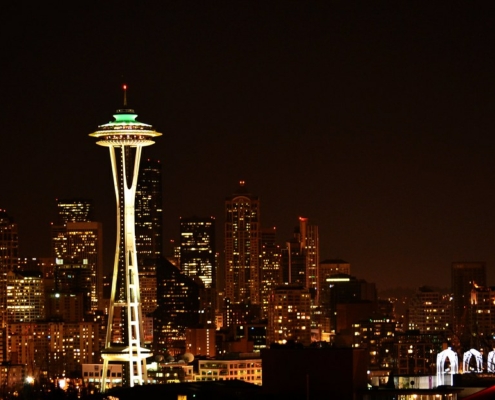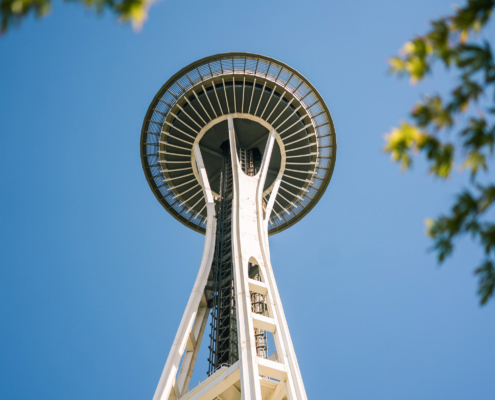"
The opening of the Century 21 Exposition on April 21, 1962 transformed the image of Seattle and the American Northwest in the eyes of the world. The region, which had been known until that point more for its natural resources than as a cultural capital, established a new reputation as a center of emergent technologies and aerospace design. This new identity was embodied by the centerpiece of the exposition: the Space Needle, a slender assemblage of steel and reinforced concrete which became—and remains—Seattle’s most iconic landmark. The idea for the Space Needle itself came from Germany. When Seattle World’s Fair Commission chairman Eddie Carlson dined in a restaurant in Stuttgart’s Fernsehturm in 1959, he quickly decided that the Century 21 Exposition required a similar landmark attraction. He wasted no time in sketching out his vision of this tower on a number of postcards sent to other fair officials; while rather crudely detailed, the slender form of his concept drawing was clearly inspired by the Fernsehturm. In response, one of the officials suggested that Carlson enlist architect John Graham, Jr. to turn his sketch into a reality. The collaboration between Carlson and Graham resulted in substantial revisions to the initial concept. Early versions of the Space Needle resembled an enormous balloon, either tethered to the ground or sitting atop a column; it was Graham who turned the sphere into a saucer, a form perhaps more fitting in light of the tower’s Space Age inspiration. Approximately a dozen designers contributed to the project, each recruited into a team by Graham for the task. One member in particular, Victor Steinbrueck, was responsible for the tripod support shaft; its double-decked crown was concocted by member John Ridley. The final design was decided upon only a year and a half before the fair’s intended opening in 1962. The next six months were spent securing a lot upon which to build the tower. Although the Space Needle was to be the exposition’s greatest attraction, its construction was not financed by the city; the investors, therefore, had to purchase a lot within the fairgrounds. Eventually, a 14,400 square foot site was found, and construction could finally begin with only a year left before the beginning of the Exposition. The concrete pour for the foundation would be the largest attempted in the West to that date: over the course of an entire day, a total of 467 cement trucks worked to fill the gaping hole. The resulting foundation was so heavy that it weighed as much as the tower that sprouted from it. In spite of the Space Needle’s slightly top-heavy appearance, its center of gravity is only 5 feet above the ground. From this massive foundation arose a slender tower whose skyward growth did not end until it had reached 605 feet tall. The structure comprises a steel tripod, with each of the three legs pinched just above the middle of their height and topped by a multi-level tophouse reminiscent of a flying saucer. This tophouse consists of five stacked layers: a revolving restaurant, a mezzanine level, an observation deck, a mechanical equipment level, and at the tower’s pinnacle, an elevator penthouse. The structure was also originally crowned by a 50 foot natural gas torch. In the late 1990s, the Space Needle was declared a historic landmark by the Seattle City Council – the first structure to qualify in each of the six potential criteria for the title. Once built as a heady vision of a spacefaring future, it is ironically now recognized as a relic from decades past. The city around the Space Needle has changed since 1962. It now enjoys the commercial diversity so intently sought by the fair’s organizers, apparently validating their efforts. The Space Needle now stands as a symbol of the bright 21st Century Seattle hoped for in 1962 – albeit not quite the way they envisioned it.
"
Information provided in part by: Arch Daily







